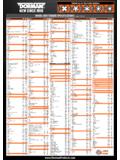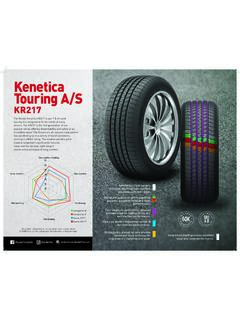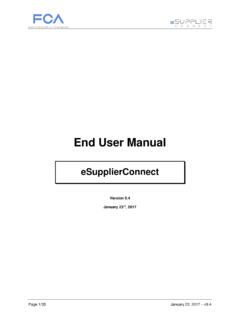Transcription of Carter ThermoQuad Information Page Overview
1 Carter ThermoQuad Information Page Overview The Carter ThermoQuad carburetor is an American designed and built carburetor, and was original equipment on many American chrysler V8 vehicles built during the 1970s. It was fitted to Australian manufactured Ford vehicles fitted with V8 gasoline engines built between 1977 and 1982. These years correspond to the Falcon models XC through to XE. The Carter Thermo-Quad is a four-barrel carburetor with a spread bore throttle bore configuration. It was designed as an emissions capable carburetor that retained or surpassed secondary throttle performance of earlier Carter carburetors, while delivering superior primary fuel economy. The Thermo-Quad consists of three main sub-assemblies; an aluminum fuel bowl cover, a phenolic resin main body, and aluminum throttle base assembly. The Thermo-Quad derives its name from the phenolic main body. Due to the material of the body, the carburetor bowl can stay 20 degrees cooler than an all-metal carburetor in the same environment.
2 chrysler Corporation used the Thermo-Quad in cars and trucks 1971-1984. Carter also produced aftermarket versions. This guide is intended to provide Information for identifying Thermo-Quad carburetors and related items. It provides a basic history and basic descriptions of the carburetor and its subsystems. It is not intended as a full theory of operation manual or a repair manual. Service documentation should be consulted for repair procedures and service details. The factory service manuals provide good service procedures and theory for specific models. Other sources may be consulted for general repair and modification procedures as well as theory of operation. See the list of references for sources. This guide is written with carburetor 'swapping' in mind. Thus, certain items are discussed with modification consideration (ie. emission subsystem disablement) with the intent for adapting a non-original carburetor and/or enhancing performance.
3 The modification and adaptation of the carburetors may present legal issues, so consider the interest of any appropriate government(s). As fitted to Australian vehicles, the ThermoQuad is a two-stage four-barrel carburetor with electrically activated automatic choke. It is a spread bore design, with secondary throats twice the size of the primaries. See the picture below for an illustration of the relative size of the throttle bores. The secondary throttles are opened by a mechanical linkage to the primary throttles, starting to open when the primary throttles are roughly 3/4 open, with both primary and secondary throttles becoming fully open at the same time. A spring loaded, vacuum operated air-door above the secondary throats prevents airflow through the secondaries until engine demands are sufficient to use the extra flow, thus aiding a smooth transition to wide-open throttle. id19975328 pdfMachine by Broadgun Software - a great PDF writer!
4 - a great PDF creator! - Features The Carter ThermoQuad features a plastic (phenolic resin, actually) main body (visible as the dark center section in the above photographs). The main body contains the fuel reservoir, and the plastic construction is claimed to keep the fuel cooler than a metal body would, thus enabling more accurate fuel metering. The primary fuel metering system features mechanical and vacuum controlled metering rods, which eliminate the need for a power valve circuit within the carburetor. Opening the throttle mechanically raises the metering rods proportionally, thus richening the mixture according to throttle position. Rod position, and hence mixture richness, is further controlled by engine vacuum, resulting in a fuel mixture that is always tailored to instantaneous engine load. The carburetor is fully tunable. External idle mixture screws enable precise adjustment of the idle mixture. The primary circuit metering rods are adjustable and replaceable without disassembly of the carb.
5 The primary metering circuit also includes replaceable jets, and replaceable metering rod step-up springs. Variation of step-up spring strength and preload enables adjustment of the rate at which the mixture richens in relation to engine vacuum and hence load. The secondary metering circuit features replaceable jets. It is also possible to adjust the rate at which the secondary air-door opens, enabling activation of the secondary throats at higher or lower engine loads, depending on the needs of a particular engine. The automatic choke mechanism features automatic choke activation, automatic choke pull-off, an initial throttle setting for starting, an automatically reducing throttle setting as the engine warms up, and disabling of the carburetor secondary throats whilst the engine is cold. The choke activation temperature, pull-off rate, and cold-engine fast idle speed are all fully adjustable. Two timed-vacuum ports are provided on the front of the carburetor base.
6 PERFORMANCE CONSIDERATIONS: Although not having a reputation locally as a performance carburetor, the Carter ThermoQuad is nonetheless a sizeable four-barrel carburetor. The fully adjustable nature and spreadbore configuration enables tuning for maximum power at wide-open throttle, with excellent economy and emissions under cruise and idle conditions. American ThermoQuads are rated at between 800cfm and 1000cfm, which is more than enough for almost any street driven engine, and these carburetors have been popular aftermarket fitments in that country. Hearsay has it that Australian ThermoQuads are rated at 600cfm, although I have not been able to confirm this. Even at 600cfm, this represents air-flow the equivalent of the most popular performance Holley four-barrel. History and General: The Thermo-Quad (TQ) was initially released for competition in 1969. chrysler introduced the TQ on the 1971 340. The first series of TQs including the 71 340 version and the Competition Series TQs were air metered units unlike like the 72 and later TQs which were solid (liquid) fuel metered.
7 The Competition Series (CS) was available in 850 cfm and 1000 cfm ratings. CS units use a manual choke and have a minimal amount of external attachments compared to OEM production units. The CS was discontinued in the mid-70s. Carter released the 9000 series in the latter 70s as replacement carburetors for chrysler and GM Quadrajet applications. The 9000 series was very similar to the production chrysler Thermo-Quads. In 1972, the OEM chrysler TQs changed to the solid fuel metering type. The TQ coverage was expanded to include the 400 engine. By 1973, all chrysler 4-bbl applications were TQs (except some 413 truck models which continued to use a Holley carburetor). As the years progressed, the TQ evolved to meet the continually tightening emissions requirements. The changes were numerous. Many features were added or modified externally and internally. The late 70s contained many variations for the various geographic regions, the various features included/excluded, and the range of applications and engines produced.
8 Into the 80s, the TQ became more complex, but year-to-year major variation lessened somewhat. In 1973, TQs received a port on the base for canister purge and a port on the main body to provide a venturi vacuum signal for EGR applications. 1975 saw the introduction of the Idle Enrichment system, Altitude Compensator on some models, and the Throttle Position Solenoid for the new catalytic converter equipped cars. In 1976, chrysler introduced Lean Burn ignition and the TQ was modified to produce and run on a very lean air/fuel mixture. An external idle stop switch and throttle position transducer were added. In 1978, the TQ bowl vent was modified with the addition of an electric Bowl Vent solenoid. An additional rear base port for the vent hose replaced the bowl vent port. The fuel inlet moved to the rear center of the carburetor from the previous rear side location. Lean Burn became Electronic Spark Advance (ESA) in 1979. The very lean mixture idea was abandoned, but the electronic control of the ignition advance was retained.
9 Hidden mixture screws were a feature starting with some 1980 model TQs. 1981 introduced a riveted cover for the choke pull-off linkage to prevent tampering and the oxygen feedback solenoid on some models. Idle Enrichment and Altitude Compensator was not used on feedback models. 82-84 did not change much more in a major way. The canister purge was eliminated by 1984 in some applications and a power brake port was added to the rear base. After 1984, chrysler stopped using Thermo-Quads. Instead, the Rochester Quadrajet was used through 1989 on cars and until 1988 in trucks when Electronic Fuel Injection replaced them. Carter continued to supply the fuel pumps for the Quadrajet equipped vehicles. Although chrysler was the primary manufacturer to use the TQ, International Harvester (IHC) used them in the late 70s and Ford used them in 1974. The Thermo-Quad was available with two primary throttle bore sizes, 1-3/8" and 1-1/2". Flow ratings (CFM) vary depending on the source, but the TQs with the 1-3/8" bores are listed as 750-800 CFM and those with the 1-1/2" primary throttle bores are rated at 800-850 CFM.
10 All TQs have the 2-1/4" diameter secondary throttle plates. The primary bore size depended on application. In general, all 78 and later 318s and 360s and all 340s had the smaller bore. Earlier 360s varied depending on application, most 400s and all 440s had the large bore. The 9000 series have the small primary bore and were rated by Carter at 800 cfm. Later TQs (ie, Lean Burn and ESA applications, feedback systems) are quoted with less flow ratings, but this is due to the control of the carburetion system, not the inherent flow capability of the basic carburetor. The internal metering is set for leaner running conditions for Lean Burn. Either bore size can be tuned to run well on most engine combinations. The smaller bore offers a slight increase throttle response but less overall flow. The different bore sizing, ie. spreadbore, is an aspect that can lead to increased fuel economy while delivering similar wide open throttle (WOT) performance to an equivalent standard bore configuration.


